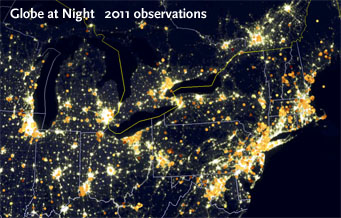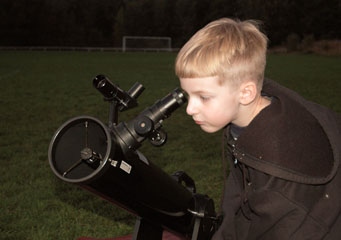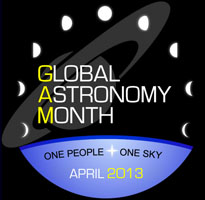Amateur skygazers can satisfy their celestial cravings with Globe at Night, International Dark-Sky Week, Astronomy Day, and Global Astronomy Month.
Ah, spring! When a nature-lover's fancy turns to thoughts of … stargazing! After many of us have endured too much cold and too much snow the past few months, it's time to head outdoors to enjoy all that the night sky has to offer. And April, especially, provides many avenues for revitalizing your interest in stargazing.

Observations by volunteer skygazers during the 2011 Globe at Night campaign (colored dots) appear over a nighttime satellite composite image of the Northeast U.S. and southern Canada.
Globe at Night
One quick and easy way is to participate in Globe at Night, a worldwide star-counting exercise that you can do alone or with your family and friends. I'm a big fan of this program, now in its eighth year. Here's how it works. First, you'll need a clear night with minimal interference from moonlight. Next, go outside at least an hour after sunset — say, 8:30 p.m. or later here in the U.S. — and estimate the limiting magnitude of your night sky. Sky charts from Globe at Night make it easy to determine the darkness of your night sky. Then jump online to report your observation. You'll need to know your latitude and longitude, but the website has a mapping tool to help you figure that out. Go for it!
April 5th to 11th is International Dark Sky Week. Also designed to draw attention to light pollution, IDSW was conceived in 2002 by high-school student Jennifer Barlow. She's all grown up now, but her core message is the same: reducing light pollution is a win-win situation that saves energy, reduces greenhouse gases, protects the environment, and improves human health. You can participate in simple ways: check around your home to ensure that outdoor lighting is fully shielded, or at least angled downward; talk to your neighbors about the value of dark skies; attend (or host!) a neighborhood star party! These ideas and more are detailed on the International Dark-Sky Association's IDSW web page.

A budding stargazer takes a peek during a locally organized star party in Chelmsford, Massachusetts.
J. Kelly Beatty
Coming up fast is Astronomy Day, which this year falls on April 20th. One of the most important and enduring annual stargazing events, Astronomy Day got its start in 1973. It's a high-profile way to draw public attention to the science and the hobby of astronomy through exhibits and activities at urban centers. Astronomy clubs, observatories, museums, colleges, and planetariums worldwide now host special family-oriented Astronomy Day events and festivities. Some organizations extend their activities over an entire week. Check out the Astronomical League's Astro-Day page for details.

Global Astronomy Month offers a wide range of sky-related activities at venues around the world and online.
Astronomers Without Borders
Finally, even if you can't find a local venue to whoop it up, you can join the worldwide celebration of the night sky thanks to Global Astronomy Month. Spearheaded by the "One People, One Sky" folks at Astronomers Without Borders, GAM is the world's largest global celebration of astronomy. It embraces all kinds of activities in many different venues: Sun Day, astro-poetry, an astrophoto contest, Jupiter and Saturn "watches", and much more. There are even online-only events like "Walking on the Moon" and the "Cosmic Concert." Check out GAM's program schedule for details.
With so many activities on tap, something here will surely be interesting — even you're just a casual skygazer.
 0
0









Comments
You must be logged in to post a comment.